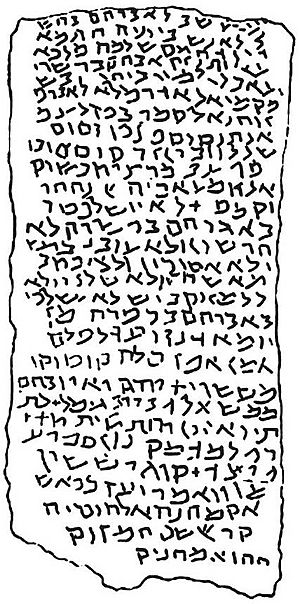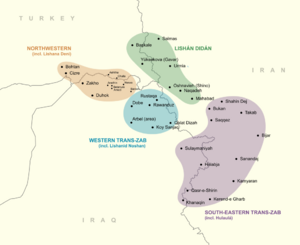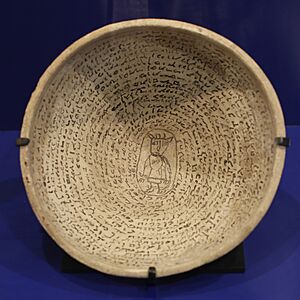Judeo-Aramaic languages facts for kids
Judaeo-Aramaic languages are a group of languages that are part of the Aramaic family. They were spoken by Jewish communities and were influenced by the Hebrew language. These languages are also sometimes called Neo-Aramaic.
Contents
Aramaic: An Ancient Language
Aramaic is an ancient language, much like Hebrew. Both belong to a group called Northwest Semitic languages, which means they share many similar features.
Around 700 years before CE, Aramaic became a very important language across the Middle East. It was used for talking between different countries and for trade. It was like a common language that many people understood.
At first, ordinary Hebrew people did not use Aramaic. For example, in the Bible (2 Kings 18:26), King Hezekiah's messengers asked to speak in Aramaic. They did this so that the common people would not understand their discussions.
How Aramaic Became More Common
During the 6th century BCE, many Jewish people were taken to Babylon (modern-day Iraq). This event, known as the Babylonian captivity, made Aramaic a part of their daily lives.
Around 500 BCE, Darius I of Persia, a powerful king, made Aramaic the official language for the western part of his empire. The specific type of Aramaic spoken in Babylon became the standard.
Over time, Jewish people slowly started using Aramaic more and more. Here's how the change happened:
- At first, Hebrew was the main language for daily life and society. Other similar languages were also known.
- Then, Aramaic started being used for international talks and foreign trade.
- Next, Aramaic was used for communication between people and for government tasks.
- Slowly, Aramaic became the language used in public places, like markets.
- Finally, Aramaic began to replace Hebrew in homes. Hebrew was then mostly used for religious activities.
This change took a long time, and it happened differently in various places and among different groups of people. Using one language over another often showed a person's social status, political views, or religious beliefs.
From Greek Rule to Jewish Communities Around the World

When Alexander the Great conquered the Middle East around 331 BCE, Greek became the main language. However, Aramaic continued to be spoken in many areas.
Judaea (the land of the Jewish people) was one place where Aramaic remained strong. Jewish communities in Babylon also continued to use it. As Greek became more powerful, Hebrew was used less and less in everyday Jewish life. It became known as the holy tongue.
Early Jewish writings from this period, like parts of the books of Daniel and Ezra in the Bible, show how Aramaic was used. These writings also show how Jewish Aramaic started to take on some features from Hebrew.
Over time, different types of Aramaic appeared. The Aramaic spoken in Babylon was still seen as the most correct form. This led to clear differences between the western and eastern dialects of Aramaic.
As fewer people understood original Hebrew scriptures, Targumim became very important. These were translations of Jewish scriptures into Aramaic. At first, they were simple retellings. Later, official standard Targums were created, like Targum Onkelos and Targum Jonathan. These were originally in a Palestinian dialect but were changed to follow Babylonian usage. Eventually, these Targums became standard in Judaea and Galilee too.
Even among religious scholars, who still understood Hebrew, Aramaic was used in many important religious texts. It appeared in the Dead Sea Scrolls, and to some extent in the Mishnah and the Tosefta alongside Hebrew.
Jewish Communities Spread Out
The First Jewish–Roman War in 70 CE and the Bar Kokhba revolt in 135 CE caused great changes for Jewish society. Many Jewish communities were broken up. However, Jewish schools in Babylon continued to thrive. In the west, rabbis settled in Galilee to continue their studies.
By this time, Jewish Aramaic was quite different from the official Aramaic of the Persian Empire. Middle Babylonian Aramaic became the main dialect. It is the basis for the Babylonian Talmud, a very important Jewish text.
Middle Galilean Aramaic, a dialect from the north, also influenced writings in the west. It was likely the first language of the Masoretes. These scholars created special marks to help people pronounce Hebrew and Aramaic scriptures correctly. So, the vowel marks you see in many Hebrew Bibles might actually show how Middle Galilean Aramaic was pronounced.
As Jewish people spread out more across the world, Aramaic slowly gave way to other languages. Just like Hebrew before it, Aramaic eventually became a language mainly used by religious scholars. Even in the 13th century, the Zohar, a mystical Jewish text, was written in Aramaic in Spain. The popular 16th-century Passover song Chad Gadya, from Bohemia, also shows how important the language of the Talmud remained.
Jewish Aramaic in the 20th Century
Aramaic continued to be the main language for Jewish communities in Mesopotamia (modern-day Iraq and parts of Turkey and Iran). At the start of the 20th century, many small Jewish communities still spoke Aramaic. They were spread from Lake Urmia to the Plain of Mosul, and as far east as Sanandaj.
In some places, like Zakho, Jewish and Christian communities could easily understand each other's Aramaic. In other places, like Sanandaj, they spoke different forms of Aramaic and could not understand each other. Even among different Jewish dialects, understanding each other became difficult.
In the mid-20th century, the creation of the State of Israel changed everything. Many Aramaic-speaking Jewish communities moved to Israel. Today, most people who speak Jewish Aramaic as their first language live in Israel. However, their unique languages are slowly being replaced by Modern Hebrew.
Modern Jewish Aramaic Dialects
The modern Jewish Aramaic languages are still known by the places where they were spoken before Jewish people moved to Israel. These include:
- Lishana Deni—originally spoken in the Kurdistan Region of Northern Iraq and Southeastern Turkey.
- Lishan Didan—originally spoken in Iranian Azerbaijan and the Lake Van area in Turkey.
- Lishanid Noshan—originally spoken in northeastern Iraq in the region of Arbil.
- Hulaulá—originally spoken in Iranian Kurdistan.
- Barzani Jewish Neo-Aramaic (or Lishanid d'Janan)—originally spoken in three villages near Aqrah in Iraq.
- Betanure Jewish Neo-Aramaic (or Lishan Huddaye)—originally from the village Bar Tanura in Iraq.
See also
 In Spanish: Dialecto judeo-arameo para niños
In Spanish: Dialecto judeo-arameo para niños
- Jewish Babylonian Aramaic
- Jewish Palestinian Aramaic
- Galilean dialect
- Israelian Hebrew
- Semitic languages
- Aramaic studies
Sources



